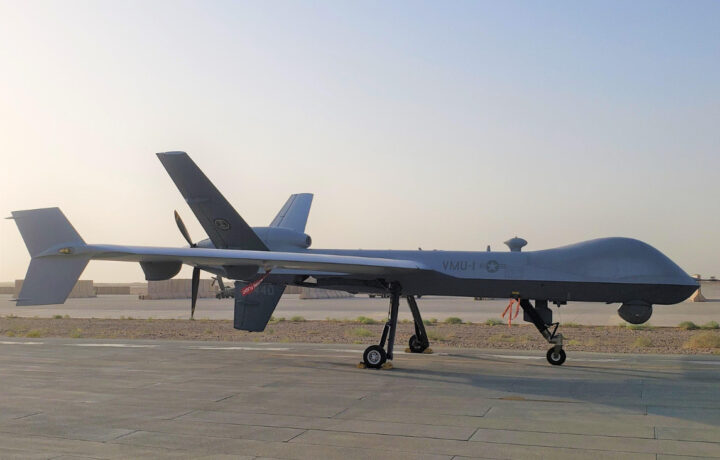In September, the United States Air Force reactivated a World War II fighter squadron, but with a new 21st-century mission. The 431st Expeditionary Reconnaissance Squadron, formerly the 431st Fighter Squadron, was first formed in 1943 to escort bombers. It was later returned to action as the 431st Fighter-Interceptor Squadron and then as the 431st Tactical Fighter Squadron.
It was later reactivated as the 431st Tactical Fighter Training Squadron and then the 431st Fighter Weapons Squadron. From 1981 to 1992, it was redesignated the 431st Test and Evaluation Squadron.
The unit’s new mission won’t involve flying fighters or interceptors, nor will it be engaged in training or evaluation. Instead, in its new form, it will be a tenant unit of the 8th Fighter Wing, operating the General Atomics MQ-9 Reaper drones.
Last week, Lt. Col. Douglas J. Slater formally assumed command of the 431st ERS, which will operate from Kunsan Air Base, Republic of Korea.
“It’s an honor to write the next chapter, side by side with our Korean allies,” said Capt. Ryan Jayawardena, 431st director of operations. “Activating the 431st reflects our shared commitment, hard work, and the strength of an alliance ready for today’s challenges.”
Commitment to South Korea
The reactivation is part of the United States Air Force’s commitment to promote peace and security on the Korean Peninsula. Previously, the Air Force repositioned its fleet of F-16 Fighting Falcons, creating a so-called “Super Squadron” at Osan Air Base.
Nine of the F-16s came from Kunsan Air Base, along with approximately 1,000 United States Air Force airmen and other personnel. The bases are only about 105 miles apart, with Kunsan AB located on the southwest coast of South Korea, about 110 miles south of Seoul, while Osan AB is about 40 miles south of the Republic of Korea’s capital. The latter base is also the headquarters of the Republic of Korea Air Force (RoKAF) Operations Command, and it serves as the arrival point for US government-contracted “Patriot Express” flights that transport US service members, as well as their families, from the United States and Japan to South Korea.
“The activation of the ERS reinforces the dedication of the U.S. to peace and security on the Korean Peninsula. MQ-9 operations will support U.S.-Korean priorities in intelligence, surveillance, and reconnaissance across the Indo-Pacific theater, enhancing the joint capability to respond to threats and emerging situations while strengthening our alliance,” the Air Force explained.
The Message to America’s Adversaries: Do Fear the Reaper
The MQ-9 Reaper was designed to serve as a multi-mission, medium-altitude, long-endurance remotely piloted aircraft. It can be used to conduct intelligence, surveillance, and reconnaissance (ISR) missions, including those in humanitarian aid and disaster response roles. However, as its name suggests, the Reaper can also conduct strikes on targets.
Designed as a follow-up to the MQ-1 Predator, the Reaper can carry a substantial amount of ordnance, enabling it to fulfill the “hunter” component of a hunter-killer drone. Each of the drones can carry double the amount of Hellfire missiles that the Predator can carry, while the MQ-9 can also carry up to 500 pounds of bombs.
The Reaper can also be armed with up to eight laser-guided missiles. The Air-to-Ground Missile-114 Hellfire possesses highly accurate, low-collateral damage, anti-armor, and anti-personnel engagement capabilities. Even as the U.S. Air Force seeks to develop more autonomous and capable drones, the MQ-9 has continued to be updated and enhanced.
The MQ-9 has a range of more than 1,600 miles (2,575 kilometers) and can stay airborne indefinitely, as it can be refueled in flight. With that range and endurance, it could reach all of North Korea, as well as much of the East China Sea and Taiwan, serving in an ISR role while also targeting potential strike points throughout the region.
“Deploying the MQ-9 brings a powerful capability to the region,” said Slater. “We’re here to support the mission, deepen cooperation, and demonstrate our shared commitment to maintaining security and stability across the Indo-Pacific.”
The MQ-9 will carry on the legacy of the unit that previously operated such aircraft as the Lockheed P-38J Lightning, the North American F-86F Sabre, the Convair F-102A Delta Dagger, and the McDonnell F-4D Phantom II, among other noteworthy aircraft.



